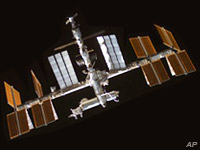Moving slowly and deliberately, a pair of white-gloved hands reach out, grasp a white cloth and carefully pull it back, revealing a manila envelope. The hands then deftly move to the envelope, pick it up and present it to onlookers.

The scene is from a NASA video, and the hands belong to a character known as “R2,” or Robonaut 2 — a startlingly humanoid looking robot currently prepping to fly to the International Space Station aboard the last scheduled space shuttle mission in September.
R2 — the product of a joint venture between NASA and General Motors — looks the way it does because it is different from the many robots the space agency has already sent out to explore the solar system, or even the robot already aboard the space station, a Canadian-made robotic arm called “Dextre.”

This one is meant to be an astronaut’s helper, NASA spokesperson Ashley Edwards told TechNewsWorld, so its form matters.
The robot’s hands are shaped like human hands, to be able to hold tools astronauts will use. Its head is shaped like a human’s to provide stereoscopic vision and a field of view similar to its human counterparts.
“We need it to be able to move throughout the International Space Station, to be able to reach for tools the same way a human would,” she said.
Now With Robo-Assist!
So far, Robonaut 2 is largely a test prototype, according to NASA. It lacks legs or any other way to get around, for instance, and it hasn’t yet been tested against the rigors of spaceflight and life on board the space station.
However, if it behaves as engineers expect it to, it could become a space station butler of sorts, helping astronauts set up tools and tear down work sites — rote work that takes much time away from uniquely human skills.
It could also go on some space walks and take on tasks that are too dangerous for humans to safely tackle, NASA said.
“The idea is not to replace humans ever, because the human experience is what we’re all about,” Edwards said.
Robots Key to Exploration
NASA is hatching plans to send robots ahead to likely destinations for human spaceflight, said Edwards, to check for dangers and lay the groundwork for people to arrive.
The agency hopes to spend about US$3 billion over the next five years on what it calls “robotic precursor missions.” Such missions might include landing a remote-controlled video-streaming robot on the moon, or sending a robot to an asteroid to process materials for use in spaceflight.
Using robots in space exploration is an efficient use of NASA’s limited budget, said Bruce Betts, director of projects at The Planetary Society, which advocates for continued space exploration.
“Human life is precious, as is humans’ time in space,” he said. “By using robots for tasks they can do, it frees up humans to focus on tasks that really need a human.”
GM Stake
The research, which was underwritten by an undisclosed contribution from GM, will give the U.S. a competitive advantage in space robotics, according to Edwards.
It may also reap benefits on the ground, as spaceflight research often does.
GM, which uses robots in some of its manufacturing processes, sent a team of engineers to NASA’s Houston facilities to work on the project. The automaker wasn’t particularly interested in making a human-shaped robot, spokesperson Daniel Flores told TechNewsWorld.
“From a GM perspective, the advanced robotics partnership provides us the opportunity to develop technology that will enable us to build safer cars and build them in safer plants,” he said.
As for when the technology gleaned from the Robonaut 2 project might make it to plant floors, Flores said the company had nothing specific to announce.
Robonaut 2 is currently undergoing a $7.5 million testing and certification process, which it must pass before it can be cleared for spaceflight. It is scheduled to fly on STS-133, which is scheduled to depart for the space station on Sept. 13.




















































